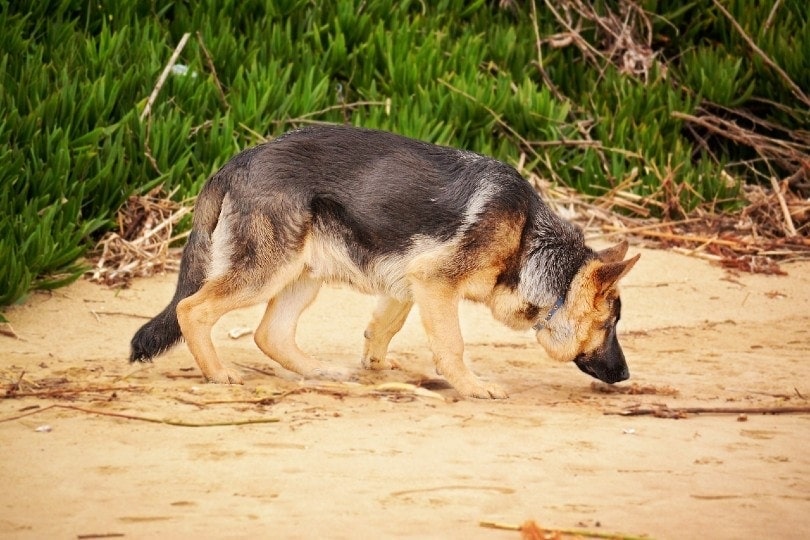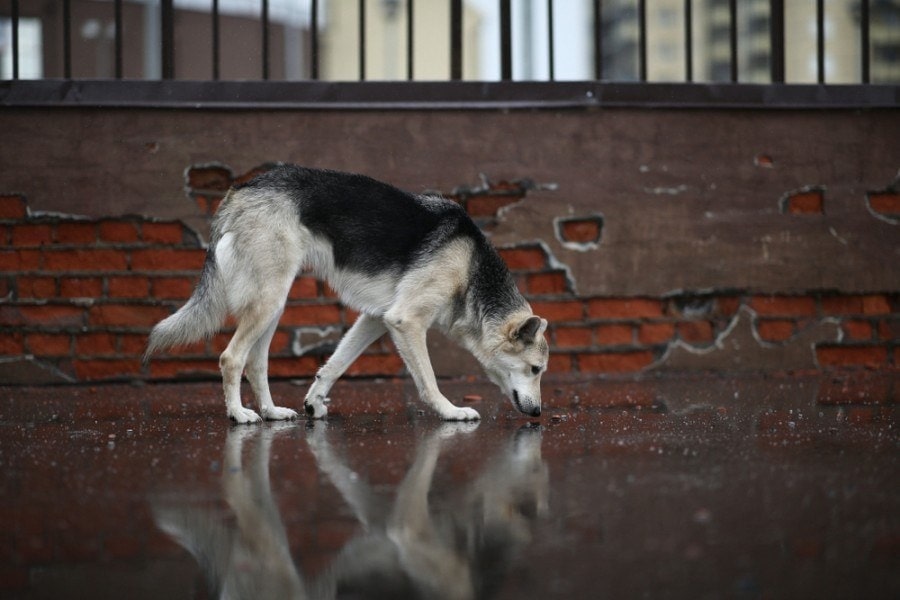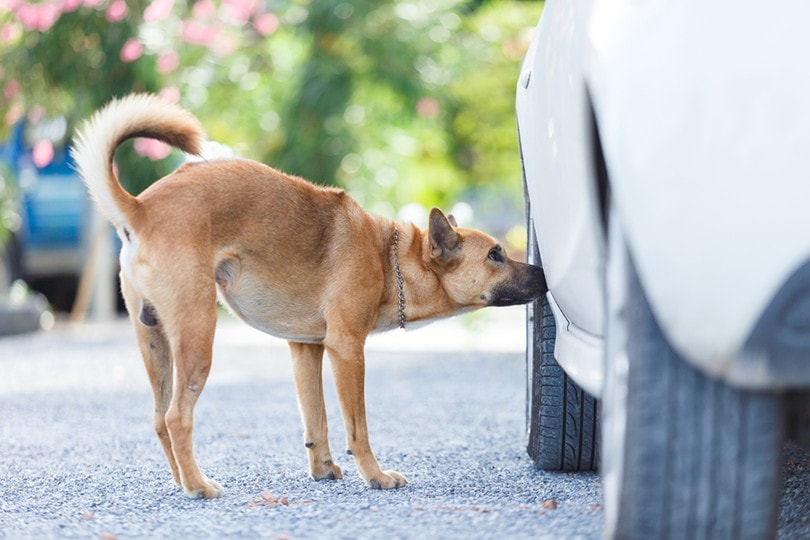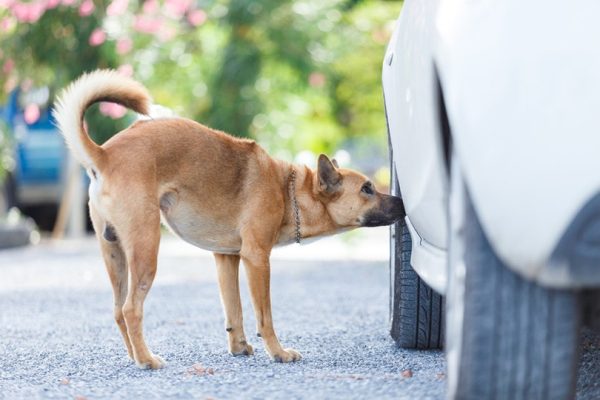Dogs have a powerful sense of smell that is 1 million times more acute than that of a human. This incredible skill makes them excellent hunting companions and helpers for people with scent blindness, but it also has many other applications. In general, dogs have about 20 times the number of smell receptors as humans do. A dog’s nose contains up to 300 million olfactory receptors (humans have about 6 million), and the part of their brain devoted to smell is about 40 times greater than ours. So, just how far can dogs smell? In perfect conditions, the average dog is reported to smell things as far as 20 km (12.4 miles) away.

How Far Can a Dog Smell?

Large dogs have larger olfactory bulbs and a stronger sense of smell than small dogs. Dog breeds that are bred to track and hunt, like German Shepherds or Beagles, also have a better-developed sense of smell than most other breeds.
Approximately 40% of a dog’s brain is devoted to smell. Humans have about 6 million olfactory receptors. Most dogs have about 100 million. Scent hounds have up to 300 million.
- Bloodhounds — These dogs have a long history of scent tracking for law enforcement. Bloodhounds sense of smell is considered to be so accurate that it is even accepted in a court of law.
- Beagle — Beagles are frequently used to sniff out narcotics for U.S. Customs and Border Patrol agents.
- German Shepherd — This is the leading dog breed for use in the police force and the military. These dogs use their incredible sense of smell for narcotics detection and search and rescue.
- Dachshund — The small but mighty Dachshund excels at detecting smells below ground. This breed was originally bred to hunt badgers and underground vermin.
- Harrier — Harriers earned their name due to their excellent ability to track hares. They are dedicated hunters that can sniff out prey from miles away.
- Basset Hounds — Second only to Bloodhounds for their sniffing abilities, these dogs are frequently used for search-and-rescue missions.
- Coonhounds — Coonhounds of many varieties are used as hunting dogs because they can track scents for miles. Their sense of smell is so refined that they can detect faint scents left behind for days.
- Labrador Retrievers — Labs excel at scent detection. They are used for search-and-rescue missions, and some are even trained to detect the smell of cancer. The U.S. Army frequently relies on Lab Retrievers as bomb sniffers.
- Golden Retriever — This breed is used for search and rescue, and many are trained as service dogs to sniff out potential allergens for their owners.
- Belgian Malinois — The Malinois is a popular military service dog because their keen sense of smell enables them to detect explosives. This breed is the only dog breed used by the Navy SEALS. Along with their excellent sense of smell, they have amazing speed and endurance that lends them to emergency takedowns of suspects or enemy combatants.
A Dog’s Smelling Distance Compared to Other Animals
| Animal | Maximum Smell Distance Under Perfect Conditions |
| Dog | 20 km |
| Human | 2 m (0.02 km) |
| Polar Bear | 30 km |
| African Elephant | 19 km |
| Cow | 10 km |
| Grizzly Bear | 32 km |
| Moth | 7 km |
| Cat | 6 km |

Which Factors Influence a Dog’s Sense of Smell?
Weather conditions have a direct impact on a dog’s smell range. On a hot day, smells travel farther. Wind can carry a smell toward or away from a dog’s nose. In cold weather, smells settle close to the ground. Other factors also affect a dog’s sense of smell:
- Health status — A dog with a gum infection, for example, won’t be able to smell as well as a dog without one.
- Age — Like humans, dogs’ hearing, sight, and sense of smell decrease as they get older.
- Diet — A dog that eats a well-balanced, healthy diet will be better able to maintain their sense of smell than one that is malnourished.
Dogs Use Their Sense of Smell in Everyday Life

Dogs use their sense of smell to explore the world around them and interact with other dogs and people. They also use it to communicate. Herding dogs like Border Collies use their sense of smell to help manage their flocks. Retrievers like Labrador and Golden Retrievers use it to find fish, and hunting dogs like Beagles use their scenting ability to find game.
A dog’s sense of smell can be used to help people with issues that impair their sense of smell, like Parkinson’s disease or cystic fibrosis. Dogs are also often used in search-and-rescue missions to find people trapped in natural disasters like floods or fires.
- Prey, including deer, ducks, foxes, rabbits, and other small game
- Suspects evading police capture
- Medications
- Illegal drugs
- Cancer and infectious diseases
- Peanuts and other allergens
- Bed bugs
- Missing persons
- Bombs
- Arson materials

Facts About a Dog’s Sense of Smell
Dogs’ noses are incredible! Here are a few interesting facts about a dog’s sense of smell:
- A dog has 50 scent receptors for every one receptor that a human has.
- Brachycephalic breeds, like Bulldogs, have fewer scent receptors than dogs with long snouts.
- The Bloodhound has about 300 million smell receptors. Other scent hounds have slightly fewer.
- Dogs smell and breathe through different passages in their nose.
- A dog can smell emotions, including fear, sadness, and anxiety.
- Scent-tracking dogs are trained to focus exclusively on one smell and ignore thousands of other smells.
- Search dogs often operate on air scents that are carried by the wind.
- A dog’s wet nose enables them to capture scent particles more effectively.
- Dog nose prints are like human fingerprints; no two dogs have the same nose print.
Conclusion
Dogs have a powerful sense of smell. They can smell things that humans can’t, which makes them excellent at tracking all sorts of things, from people and invisible allergens to drugs and bombs. Smell is one of your dog’s best senses. Even if they aren’t trained at scent detection, your dog uses their nose to navigate the world.
Related Reads:
- 15 Interesting Bloodhound Facts You’ll Love to Discover
- Is a Bloodhound a Good Guard Dog? Facts, History, & Alternative Options
Featured Image Credit: Damix, Shutterstock











